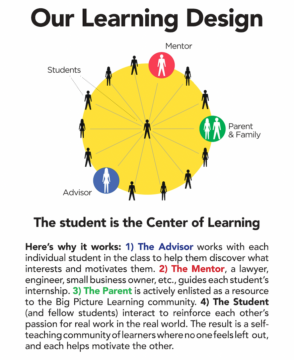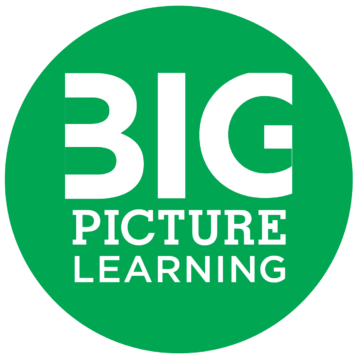Big Picture Learning (BPL) was established to challenge traditional approaches to teaching and learning. Big Picture’s focus on student-interest-driven, real-world learning reflects the knowledge that students often learn best when school is relevant to their lives, builds relationships with adult mentors and peers who share their interests, and entails genuinely authentic and rigorous work that is situated in the community and workplace.
The BPL school design is based on three core principles: 1) relationships – schools are designed to support student-centered experiences, one learner at a time; 2) relevance – student interests and real-world learning experiences shape the curriculum; and 3) rigor – assessment criteria for exhibitions of learning are aligned to professional standards. More broadly, 10 Distinguishers serve as BPL’s signature in the world of deeper learning and work-based learning. 10 Distinguishers Relationship Indicators Relevance Indicators Rigor Indicators
BPL works directly with schools to activate the potential of its students. It does not govern or operate schools but instead collaborates to transform existing schools or to establish new schools as a part of the BPL Network. Through collaboration with families and communities, each BPL school seeks to produce learning environments that are unique to local contexts. To support this, BPL offers deep partnerships, stand-alone professional development, and customized support. Today, there are over 80 Big Picture network schools in the United States and more than 100 schools around the world that utilize BPL’s design.
What Makes This Model Innovative?
Relevance
Connection & Community
Customization
Goals
BPL believes that the most important thing students need to know is how to lead lives of their own design. This means they need to know how to reason, problem-solve, and be active members of the community. The BPL model is designed around five learning goals. BPL Goals and Competencies
Personal Qualities
Students demonstrate respect, responsibility, organization, and leadership in their behavior. They also reflect on their personal abilities and strive for improvement.
Communication
Students develop skills as writers, readers, speakers, and listeners. They use technology and artistic expression to communicate with an awareness of the audience. They have also been exposed to another language.
Quantitative Reasoning
Students think like mathematicians. They understand numbers, can analyze uncertainty, comprehend the properties of shapes, and study how things change over time.
Empirical Reasoning
Students think like scientists. They use empirical evidence and a logical process to make decisions and evaluate hypotheses. They also incorporate ideas from science into other disciplines.
Social Reasoning
Students think like sociologists, historians, or anthropologists. They apply an understanding of historical patterns to thinking about current political, social, ethical, economic, and cultural issues.
Experience

At BPL, the vehicle for learning is a highly personalized student experience that is coupled with engagement in the world outside of school. Personalization is rooted in small learning communities (called Advisories) of 15-20 students who work closely with a teacher to create custom learning plans. As much as possible, school work is tied to student interests and real-world contexts. Throughout a BPLeducation, internships engage students at the intersection of their personal interests and the real world, and students share what they have learned in formal public exhibitions.
Personalized Learning: Enabling Voice & Choice Through Projects
BPL’s definition of personalization is holistic and is more than differentiation and customization. BPL schools attend to the personal growth of individual students using Advisories, which students often describe as a “second family.”
 Advisory is the core component of a BPL school. It is a small learning community of 15-20 students that is together for four years and evolves into a space of trust and respect where students are known and find their voice. As a part of their overall learning experience, Advisories help students feel that they are a part of something larger than themselves, which is essential to BPL school culture.At some BPL schools, students spend most of their time in Advisory engaged in self-directed learning or interdisciplinary workshops while others follow a more traditional schedule that still includes Advisories and internships. Advisory is where Individual Learning Plans are informed by an ongoing dialogue between students and their advisor. The dialogue itself is also informed by input from parents and mentors. Indicators of High-Quality Advisory System Sample High School Advisory Guide
Advisory is the core component of a BPL school. It is a small learning community of 15-20 students that is together for four years and evolves into a space of trust and respect where students are known and find their voice. As a part of their overall learning experience, Advisories help students feel that they are a part of something larger than themselves, which is essential to BPL school culture.At some BPL schools, students spend most of their time in Advisory engaged in self-directed learning or interdisciplinary workshops while others follow a more traditional schedule that still includes Advisories and internships. Advisory is where Individual Learning Plans are informed by an ongoing dialogue between students and their advisor. The dialogue itself is also informed by input from parents and mentors. Indicators of High-Quality Advisory System Sample High School Advisory Guide
Learning Through Interests and Internships (LTI) is a signature of BPL. It emphasizes the importance of students’ interests and integrates internships into a students’ total learning experience. LTI is not extracurricular; it is a part of the core BPL experience. Because BPL believes that learning is best accomplished in the real world, students intern once or twice a week for an entire school day. During this time, they gain first-hand experience working with adult mentors. This highlights BPL’s “Leaving to Learn” philosophy and helps students develop academic, workplace, and social-emotional competencies. Indicators of High-Quality LTI Projects
To support real-world learning, BPL developed and uses ImBlaze, a mobile platform that enables schools to curate a set of potential internships for students based on their interests. ImBlaze helps schools navigate all aspects of the overall internship process while helping students make personal connections to mentors during out-of-school learning opportunities. ImBlaze supports measurement of the depth of interest and engagement, the acquisition of skills through real work, and the development of a network of students’ professional relationships. ImBlaze Learning Through Internships: Connecting Students’ Passions to the Real World Indicators of High-Quality Internship Systems
 Individual Learning Plans culminate in Exhibitions of Learning that are core to the learning design at BPL. Individual Learning Plans These Exhibitions are attended by staff, parents, peers, and mentors and help Advisors track overall student growth and the progress of individual students. Advisors “grade” students by writing extensive narratives, and Exhibitions are an important source of insight. Students make multiple presentations each year as a part of processing and documenting their learning. The process itself is an opportunity for metacognition and growth. Sample Exhibition Rubric
Individual Learning Plans culminate in Exhibitions of Learning that are core to the learning design at BPL. Individual Learning Plans These Exhibitions are attended by staff, parents, peers, and mentors and help Advisors track overall student growth and the progress of individual students. Advisors “grade” students by writing extensive narratives, and Exhibitions are an important source of insight. Students make multiple presentations each year as a part of processing and documenting their learning. The process itself is an opportunity for metacognition and growth. Sample Exhibition Rubric
Supporting Structures
Unique needs emerge when students regularly engage in learning outside of school that is aligned to what they learn in school, and earn credit or certification for their work. To support these needs at their schools, BPL has developed a range of policies, systems, and structures.
Any curriculum can be used within the BPL model as long as it allows for personalization, real-world learning, and authentic assessment.
To personalize learning, a school’s curriculum must be robust and flexible enough to support each student’s Individual Learning Plan and off-campus learning opportunities while still addressing any state standards and competencies that are in place.
BPL students are not assessed by tests unless they are mandated by state requirements. Some BPL schools translate narratives or competency-based systems to traditional grades to meet local requirements or to facilitate the college transcript and admissions process.
Schools that are part of the BPL network exercise exceptional respect for students and place great trust in them.
To establish a culture in which students form positive relationships and find a sense of belonging, schools must be intentional in giving students voice and choice in learning. They must also be willing to include families and other members of the community at large in the life of the school, knowing that the resulting shared sense of connection is the foundation for support and celebration. School Culture
Teachers approach their roles holistically and build the habits of lifelong learners themselves in order to model these for learners.
Teachers at BPL schools have a positive impact on students because they approach their work holistically. They know that they need to do more than deliver content knowledge to be effective: they also need to advise, coach, and facilitate to ensure that all students are known in their classrooms. And, in their own learning practices, they need to self-reflect, connect, and communicate with other adults who support students.
During the hiring process at BPL network schools, candidates are often asked to engage in tasks similar to those they will have to facilitate in their Advisories. This may be a short one-on-one coaching session with a student around goal setting or some other performance-based interview task. The approach is designed to gauge a candidate’s ability to problem-solve, their ability to interact with students, and their belief that all students can succeed.
Because all students participate in internships, schools adopting the BPL model need flexibility in their schedules.
BPL schools develop unique schedules to incorporate internships as a part of their belief in real-world learning. Schools that adopt the BPL model need to be prepared to handle unique issues like tracking attendance across multiple locations in a city. To help address these issues, BPL developed ImBlaze, a platform that schools can use to manage key components of internships. Sample Schedule 1 Sample Schedule 2
BPL schools engage families and internship mentors as valued members of the school community because they play proactive roles in student learning.
Whether they are helping to develop learning plans, coaching a student through an issue, or attending exhibitions, families and mentors are integral to student success. As a proponent of out-of-school learning, BPL knows that family and community partnerships are necessary in the effort to create systemic change and champion equity in schools.
BPL encourages parents to play a proactive role in their children’s learning by collaborating in the planning and assessment of student work. As an integral part of the network that supports students, parents are welcome and valued members of the school community. Similarly, a series of mentors plays an important role in supporting student growth during the various internships that are a part of the BPL experience.
ImBlaze is a digital platform created by BPL to serve its own schools as they manage student internships, but the platform has now been adopted more widely.
ImBlaze organizes BPL internship programs from the curation of and search for opportunities, to attendance, to overall progress. It allows everyone involved in an internship to effectively interact and collaborate. The platform gives ownership of the real-world learning to students and makes it easier for mentors and teachers to help with goal setting, provide feedback, and make endorsements.
BPL schools recognize continuous improvement as a necessary part of being an effective organization in a rapidly changing world.
BPL originated from the principle that learning must have relevance in a student’s life. To maintain fidelity to this principle, BPL leaders, teachers, and staff engage in learning that helps to align vision and practice with the real-world challenges and opportunities of students. This learning can take the form of professional development at individual schools, school visits, and annual conferences.
Any curriculum can be used within the BPL model as long as it allows for personalization, real-world learning, and authentic assessment.
To personalize learning, a school’s curriculum must be robust and flexible enough to support each student’s Individual Learning Plan and off-campus learning opportunities while still addressing any state standards and competencies that are in place.
BPL students are not assessed by tests unless they are mandated by state requirements. Some BPL schools translate narratives or competency-based systems to traditional grades to meet local requirements or to facilitate the college transcript and admissions process.
Schools that are part of the BPL network exercise exceptional respect for students and place great trust in them.
To establish a culture in which students form positive relationships and find a sense of belonging, schools must be intentional in giving students voice and choice in learning. They must also be willing to include families and other members of the community at large in the life of the school, knowing that the resulting shared sense of connection is the foundation for support and celebration. School Culture
Teachers approach their roles holistically and build the habits of lifelong learners themselves in order to model these for learners.
Teachers at BPL schools have a positive impact on students because they approach their work holistically. They know that they need to do more than deliver content knowledge to be effective: they also need to advise, coach, and facilitate to ensure that all students are known in their classrooms. And, in their own learning practices, they need to self-reflect, connect, and communicate with other adults who support students.
During the hiring process at BPL network schools, candidates are often asked to engage in tasks similar to those they will have to facilitate in their Advisories. This may be a short one-on-one coaching session with a student around goal setting or some other performance-based interview task. The approach is designed to gauge a candidate’s ability to problem-solve, their ability to interact with students, and their belief that all students can succeed.
Because all students participate in internships, schools adopting the BPL model need flexibility in their schedules.
BPL schools develop unique schedules to incorporate internships as a part of their belief in real-world learning. Schools that adopt the BPL model need to be prepared to handle unique issues like tracking attendance across multiple locations in a city. To help address these issues, BPL developed ImBlaze, a platform that schools can use to manage key components of internships. Sample Schedule 1 Sample Schedule 2
BPL schools engage families and internship mentors as valued members of the school community because they play proactive roles in student learning.
Whether they are helping to develop learning plans, coaching a student through an issue, or attending exhibitions, families and mentors are integral to student success. As a proponent of out-of-school learning, BPL knows that family and community partnerships are necessary in the effort to create systemic change and champion equity in schools.
BPL encourages parents to play a proactive role in their children’s learning by collaborating in the planning and assessment of student work. As an integral part of the network that supports students, parents are welcome and valued members of the school community. Similarly, a series of mentors plays an important role in supporting student growth during the various internships that are a part of the BPL experience.
ImBlaze is a digital platform created by BPL to serve its own schools as they manage student internships, but the platform has now been adopted more widely.
ImBlaze organizes BPL internship programs from the curation of and search for opportunities, to attendance, to overall progress. It allows everyone involved in an internship to effectively interact and collaborate. The platform gives ownership of the real-world learning to students and makes it easier for mentors and teachers to help with goal setting, provide feedback, and make endorsements.
BPL schools recognize continuous improvement as a necessary part of being an effective organization in a rapidly changing world.
BPL originated from the principle that learning must have relevance in a student’s life. To maintain fidelity to this principle, BPL leaders, teachers, and staff engage in learning that helps to align vision and practice with the real-world challenges and opportunities of students. This learning can take the form of professional development at individual schools, school visits, and annual conferences.
Supports Offered
Big Picture Learning has developed a continuum of support and strategic partnership levels to support schools that want to adopt transformative, student-centered practices. This continuum can help schools and districts work creatively within existing regulations that may limit access to external learning experiences while also advancing new policies to support such experiences.
School Design Partnership
Cost Associated
BPL partners with school teams that want to adopt its design whether they are in early development, implementation, or need to refine their efforts.
BPL’s partnership strategy centers on helping schools strengthen their internal capacities through coaching, school site visits, and participation in communities of practice.
Custom Learning Opportunities
Cost Associated
To be responsive to the needs and interests of the community to be served by a school, BPL’s support strategy can be customized. BPL has helped grow student-centered, project-based learning practices around the world by aligning its work to local contexts.
Reach
Impact
Multiple studies along with accolades from the Bill and Melinda Gates Foundation and President Obama serve as evidence for the positive impact of the BPL school model.
BPL students demonstrate academic and postsecondary success. Learning Policy Institute Study, 2019
- BPL students scored higher on state assessments in math and English language arts and graduated from high school at higher rates than their district counterparts.
- 95% of students were accepted into 2-year or 4-year institutions; 88% of those who did not enroll in college secured full-time employment facilitated through an internship experience.
- BPL graduates are equally likely to enroll in college, regardless of their race, gender, or parents’ level of education.
BPL schools foster a strong sense of connection, self-awareness, and workplace readiness. Findings from The Big Picture Learning Longitudinal Study, 2020
- Students and alumni report being deeply connected to peers and adults at BPL. They also report that BPL schools excel at helping students know who they are.
- Alumni report that the BPL Learning Through Interest/Internship program helped them learn how to navigate the world of work and become more confident in the workplace.



